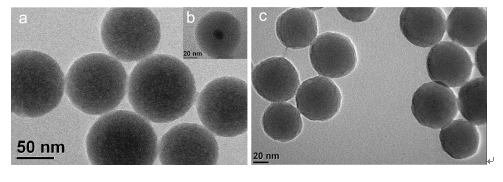| [1] Jeong, J. Y.; Cho, M. Y.; Lim, Y. T.; Song, N. W.; Chung, B. H. Angew. Chem., Int. Ed. 2009, 48, 5296. [2] Liu, J. P.; Zhang, L. L.; Wang, C.; Xu, H. Y.; Zhao, X. J. Mol. BioSyst. 2010, 6, 954. [3] Shan, Y.; Xu, J. J.; Chen, H. Y. Nanoscale 2011, 3, 2916. [4] Wu, W. T.; Shen, J.; Gai, Z.; Hong, K. L.; Banerjee, P.; Zhou, S. Q. Biomaterials 2011, 32, 9876. [5] Lu, A. H.; Salabas, E. L.; Schüth, F. Angew. Chem., Int. Ed. 2007, 46, 1222. [6] Selvan, S. T.; Patra, P. K.; Chung, Y. A.; Ying, J. Y. Angew. Chem., Int. Ed. 2007, 46, 2448. [7] Du, X. Y.; He, J.; Zhu, J.; Sun, L. J.; An, S. S. Appl. Surf. Sci. 2012, 258, 2717. [8] Ma, M.; Chen, H. R.; Chen, Y.; Wang, X.; Chen, F.; Cui, X. Z.; Shi, J. L. Biomaterials 2012, 33, 989. [9] Insin, N.; Tracy, J. B.; Lee, H.; Zimmer, J. P.; Westervelt, R. M.; Bawendi, M. G. ACS nano 2008, 2(2), 197. [10] Zou, X.; Huang, H.; Gao, Y.; Su, X. G. Analyst 2012, 137, 648. [11] Zhi, J.; Wang, Y. J.; Lu, Y. C.; Ma, J. Y.; Luo, G. S. React. Funct. Polym. 2006, 66, 1552. [12] Jiang, C. Z.; Sun, Y.; Yu, X.; Zhang, L.; Sun, X. M.; Gao, Y.; Zhang, H. Q.; Song, D. Q. Talanta 2012, 89, 38. [13] Fu, R.; Jin, X. M.; Liang, J. L.; Zheng, W. S.; Zhuang, J. Q.; Yang, W. S. J. Mater. Chem. 2011, 21, 15352. [14] Wang, R.; Han, H. Z.; Zheng, X. W.; Li, Y. H. Acta Chim. Sinica 2010, 68(17), 1726. (汪绒, 韩海洲, 郑行望, 李玉虎, 化学学报, 2010, 68(17), 1726.) [15] Triantis, T. M.; Papadopoulos, K.; Yannakopoulou, E.; Dimotikali, D.; Hrbá?, J.; Zbo?il, R. Chem. Eng. J. 2008, 144, 483. [16] Wei, H.; Wang, E. K. Anal. Chem. 2008, 80, 2250. [17] Zhang, L. N.; Guo, Z. H.; Zheng, X. W. Acta Chim. Sinica 2011, 69(20), 2486. (张李娜, 郭志慧, 郑行望, 化学学报, 2011, 69(20), 2486.) [18] He, X. X.; Shi, B. H.; Wang, K. M.; Chen, M.; Tan, W. H. J. Hunan Univ. (Nat. Sci. Ed.) 2010, 37(4), 62. (何晓晓, 石碧华, 王柯敏, 陈冕, 谭蔚泓, 湖南大学学报(自然科学版), 2010, 37(4), 62.) [19] Xia, H. B.; Foo, P.; Yi, J. B. Chem. Mater. 2009, 21, 2442. [20] Zhang, W. J.; Zhang, Y. X.; Shi, X. H.; Liang, C.; Xian, Y. Z. J. Mater. Chem. 2011, 21, 16177. |
